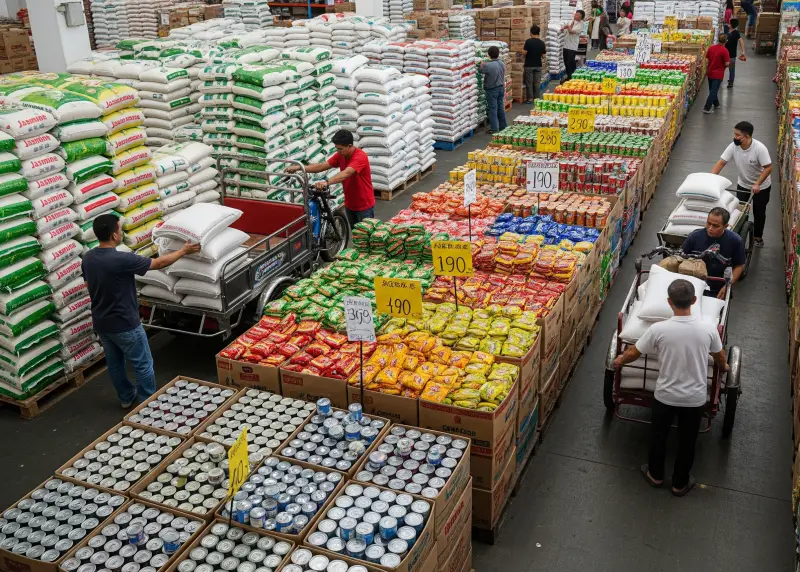In almost every Filipino barangay, you’ll find a sari-sari store. These small neighborhood shops sell everything from soft drinks and chips to canned goods, instant noodles, and even cellphone load. For many Filipinos, opening a sari-sari store is the go-to first step into entrepreneurship. It seems simple, affordable, and always in demand. After all, who doesn’t buy tingi products like a ₱5 candy or a ₱15 sachet of shampoo?
- 🏪 Why Sari-Sari Stores Remain Popular
- 💰 How Much Does It Cost to Start a Sari-Sari Store?
- 📈 How Much Profit Does a Sari-Sari Store Make?
- ✅ Advantages of Running a Sari-Sari Store
- ❌ Common Challenges and Risks
- 🔑 Key Strategies to Increase Sari-Sari Store Profits
- 🌍 Sari-Sari Stores in the Bigger Economy
- ❓ Frequently Asked Questions (FAQ)
- ✨ Final Reflection: Is a Sari-Sari Store Still Worth It?
- 🏪 References
But behind the colorful displays and the daily chitchat with kapitbahay customers lies a more complicated question: are sari-sari stores really profitable? Many families open one hoping it will supplement their income, only to close down after a few months. Others thrive for years, even passing the store down generations. So what makes the difference?
This feature breaks down the truth about sari-sari store profits in the Philippines. We’ll look at startup costs, actual margins, risks, and strategies that separate successful stores from those that fail. If you’ve ever thought of putting up a sari-sari store or already run one, this guide will help you see whether it’s worth the effort.

🏪 Why Sari-Sari Stores Remain Popular
Sari-sari stores are deeply embedded in Filipino culture. They’re not just shops – they’re also social hubs where neighbors catch up, kids buy their favorite snacks, and families purchase daily essentials without going to supermarkets. Their popularity is fueled by three main reasons: convenience, accessibility, and affordability.
For many Filipinos living paycheck to paycheck, buying in bulk isn’t possible. A sari-sari store’s tingi system solves this problem. Customers can buy one cigarette stick instead of a whole pack, or a sachet of shampoo instead of a big bottle. This accessibility makes sari-sari stores indispensable in communities.
From the entrepreneur’s perspective, sari-sari stores are attractive because they require lower startup capital compared to other businesses. With as little as ₱10,000–₱30,000, you can start a small store at home. There’s no need for fancy interiors, just a secured counter and a small investment in inventory.
💰 How Much Does It Cost to Start a Sari-Sari Store?
The cost of starting a sari-sari store depends on size and location. Some begin with just a small shelf by the window, while others invest in a full barangay corner store.
Typical Startup Costs:
-
Initial Inventory (₱10,000–₱20,000) – Snacks, canned goods, rice, toiletries, drinks.
-
Shelving and Containers (₱3,000–₱8,000) – Wooden shelves, jars, display boxes.
-
Basic Store Setup (₱2,000–₱10,000) – Counter, grills, signage.
-
Permits (₱2,000–₱5,000) – Barangay clearance, Mayor’s permit, DTI registration.
📊 Table 1: Example Startup Cost for a Small Sari-Sari Store
| Expense Item | Estimated Cost (₱) | Notes |
|---|---|---|
| Initial Inventory | 15,000 | Variety of fast-moving goods |
| Shelving/Display | 5,000 | Basic setup |
| Store Setup | 3,000 | Grills, signage, counter |
| Permits | 3,000 | Barangay + Mayor’s |
| Total | 26,000 | Approximate |
While relatively affordable, this investment is still significant for many families, which is why profit expectations need to be realistic.

📈 How Much Profit Does a Sari-Sari Store Make?
Sari-sari store profit margins are often smaller than people expect. Most items sold in stores have only a 5%–15% markup, with some essentials like rice and soft drinks giving even slimmer profits. For example, a ₱10 sachet of coffee might give you only ₱1 profit.
To make real money, sari-sari stores rely on volume and repeat customers. The more customers you serve daily, the higher your total profit. But this also depends heavily on your location and competition.
📊 Table 2: Example Daily Sales and Profit
| Daily Sales (₱) | Average Profit Margin | Daily Profit (₱) | Monthly Profit (₱) |
|---|---|---|---|
| 1,000 | 10% | 100 | 3,000 |
| 2,000 | 10% | 200 | 6,000 |
| 3,000 | 10% | 300 | 9,000 |
As shown, a small sari-sari store might earn only ₱3,000–₱6,000 per month, while a bigger one in a prime location could make ₱10,000 or more. The key is maximizing sales volume while managing expenses.
✅ Advantages of Running a Sari-Sari Store
-
Constant demand in the community.
-
Affordable startup cost compared to other businesses.
-
Flexible working hours, especially for stay-at-home parents.
-
Provides daily cash flow from small but frequent sales.
-
Can be run from home, reducing rent and utilities costs.
❌ Common Challenges and Risks
-
Thin profit margins (₱1–₱2 per item).
-
High competition, especially in barangays with multiple stores.
-
Credit (“pautang”) culture – many stores close because too much capital is tied up in unpaid utang.
-
Spoilage of items like bread, soft drinks, and frozen goods.
-
Dependency on suppliers for consistent inventory.

🔑 Key Strategies to Increase Sari-Sari Store Profits
While the profit on individual items may be small, a well-managed sari-sari store can be a significant source of income. Success lies in applying smart, consistent strategies to maximize earnings and build a loyal customer base. Here’s a deeper look into the tactics used by the most successful store owners.
Focus on Fast-Moving Goods
The lifeblood of any sari-sari store is quick inventory turnover. This means stocking items that sell out quickly, ensuring your capital isn’t tied up in products that just sit on the shelf. These are typically low-cost, high-demand consumer goods that people use daily. Think beyond just soft drinks and instant noodles; this category includes 3-in-1 coffee sachets, shampoo, soap, cooking oil, vinegar, soy sauce, and popular snacks or candies for children. Regularly observe what sells out the fastest and what customers ask for most often. By prioritizing these fast-moving products, you ensure a steady cash flow that allows you to restock and keep the business running smoothly.
Offer E-Load and Bills Payment Services
Adding digital services is one of the easiest ways to create a new, reliable income stream with minimal physical space. Offering small-value mobile phone load (e-load) and bills payment services not only earns you a small commission on every transaction but, more importantly, it drives foot traffic. A person who stops by to buy load is very likely to make an impulse purchase, like a cold drink, a snack, or a cigarette. This turns a low-margin service into an opportunity to sell your physical goods, effectively increasing the value of each customer visit.
Manage Credit Wisely with a “No Utang” Policy
Unpaid credit, or utang, is one of the fastest ways a sari-sari store can fail. It drains your working capital, making it impossible to buy new inventory. While it can be culturally challenging to refuse credit, a strict policy is crucial for business survival. A firm but polite “Bawal ang Utang” or “No Credit” sign can set clear expectations. If you choose to offer credit, limit it to a very small circle of highly trusted, regular customers with a proven payment history. Always record every transaction in a logbook and set clear payment deadlines, such as on the next payday, to keep the debt from piling up.

Buy Inventory in Bulk from Wholesalers
To increase your profit margin on each item, you need to lower your cost for acquiring it. This is where buying in bulk becomes essential. Instead of purchasing from supermarkets, source your inventory from wholesalers, distribution centers, or large public markets where prices are significantly lower. Buying a whole box of instant noodles or a case of soft drinks will give you a lower per-piece cost than buying them individually. This strategy allows you to either offer slightly more competitive prices than your neighbors or simply enjoy a higher profit margin on every sale.
Create a Clean, Organized, and Friendly Environment
Your store’s atmosphere plays a huge role in attracting and retaining customers. A clean, well-lit, and organized store is far more appealing than a cluttered, dusty one. Arrange your products neatly with prices clearly visible, making it easy for customers to see what you offer. Beyond the physical space, your attitude is key. A friendly greeting and a welcoming smile can make a huge difference. Customers are more likely to become regulars if they feel comfortable and valued. This positive experience builds loyalty and ensures they choose your store over others in the neighborhood.
Expand into Higher-Margin Products
Once you have a stable business with your fast-moving goods, consider expanding your offerings to include products with higher profit margins. Selling rice by the kilo, for example, is a staple that every household needs and offers better returns than individual snack items. Similarly, becoming a distributor for LPG tank refills or purified drinking water gallons can significantly boost your income. These items require more capital and storage space, but they serve as “anchor products” that draw customers for big-ticket purchases and often lead to them buying other smaller items while they’re at your store.

🌍 Sari-Sari Stores in the Bigger Economy
Sari-sari stores aren’t just small businesses – they’re a massive part of the Philippine economy. According to studies, sari-sari stores account for more than 30% of retail sales nationwide. Big companies like Coca-Cola and Unilever rely heavily on sari-sari stores to reach Filipino households.
This shows that while sari-sari stores may seem “small,” they actually represent a powerful network that supports jobs, livelihoods, and access to goods in remote communities. However, the flip side is that many store owners struggle to sustain their business because of the slim profit margins and lack of financial literacy.
❓ Frequently Asked Questions (FAQ)
1. How much can I realistically earn from a sari-sari store?
A small home-based store might earn ₱3,000–₱6,000 monthly. Bigger stores in busier areas can make ₱10,000 or more, depending on sales volume and customer loyalty.
2. Do I need permits to run a sari-sari store?
Yes. You need barangay clearance, a mayor’s permit, and a DTI registration for your business name. Some barangays allow informal stores, but legalizing your business prevents problems later.
3. Why do most sari-sari stores fail?
The most common reasons are thin margins, too much credit given to customers (utang), and poor inventory management. Without strict discipline, capital quickly disappears.
4. Can I run a sari-sari store while working a full-time job?
Yes, but it’s easier if a family member manages it during the day. Many successful stores are run by stay-at-home parents or retirees.
5. What items sell fastest in a sari-sari store?
Top sellers include soft drinks, instant noodles, snacks, coffee, rice, and toiletries in sachets. Load and prepaid data are also in high demand.
6. Is it better to sell more items or focus on fewer products?
Start with fast-moving essentials, then expand your offerings gradually. Too many slow-moving items tie up your capital and risk spoilage.
7. Do sari-sari stores pay taxes?
Yes. Registered stores need to pay business taxes, although very small ones under barangay permits often pay minimal fees.
8. How do I compete with bigger convenience stores like 7-Eleven?
Focus on tingi products and personal service. Many Filipinos still prefer the neighborhood sari-sari store for affordability and convenience.
9. Can sari-sari stores evolve into bigger businesses?
Yes. Many start small, then expand into mini-groceries, water refilling stations, or even wholesale distribution. The key is discipline and reinvesting profits.
10. Is a sari-sari store worth it in 2025?
It depends. If your goal is a small side income and you manage it well, yes, it’s worth it. But if you’re aiming for large profits, you’ll need to scale up or diversify.
✨ Final Reflection: Is a Sari-Sari Store Still Worth It?
The sari-sari store is more than a business – it’s a Filipino institution. It has helped countless families survive, provided jobs for stay-at-home parents, and brought communities closer together. But the truth is, running one is not as easy or as profitable as it looks. While it can provide steady cash flow, most sari-sari stores struggle with competition, low margins, and the trap of extending too much credit.
That said, a sari-sari store remains one of the most accessible starting points for entrepreneurship. With discipline, good supplier relationships, and strict financial management, it can serve as a foundation for bigger businesses. Many successful Filipino entrepreneurs began with a humble sari-sari store before branching out into wholesale, groceries, or entirely different industries.
So is it worth it? The answer depends on your expectations. If you think a sari-sari store will make you rich overnight, you’ll be disappointed. But if you treat it as a steady, side-income generator and manage it properly, it can be a practical negosyo that supports your family and opens doors for bigger opportunities.
In the end, sari-sari stores may not always deliver huge profits, but they continue to thrive because they meet real community needs. And in business, sometimes survival, consistency, and service to your neighbors are just as valuable as making millions.
🏪 References
-
Peddlr – Top 10 Fast Moving Products to Sell
-
Philstar – Sari-Sari Store Sales to Hit ₱2.4 Trillion by 2030
-
Pondopinoy PH – Tips to Improve Sari-Sari Store Sales
-
Facebook Group – Successful Sari-Sari Store Improvement Tips










